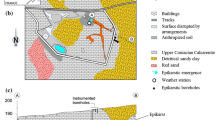Abstract
Carbon dioxide (CO2) was studied in Punkva Caves in the Moravian Karst (Czech Republic) during a one-year period from February 2012 to March 2013. Partial pressures of the CO2 corresponding to aqueous carbonates, \( P_{{{\text{CO}}_{{2}}({\text{W}}) }} \) (10−2.91–10−2.35, i.e., 0.12–0.45 vol%), and those participating in the initial dripwater formation, \( P_{{{\text{CO}}_{{2}}({\text{H}})}} \) (10−1.77–10−1.49, i.e., 1.7–3.2 vol%), were calculated from dripwater hydrogeochemistry, and compared with the partial pressure in cave air, \( P_{{{\text{CO}}_{{2}}({\text{air}})}} \) (10−3.31–10−2.49, i.e., 0.06–0.32 vol%). Both the \( P_{{{\text{CO}}_{{2}}({\text{air}})}} \) and \( P_{{{\text{CO}}_{{2}}({\text{W}})}} \) showed clear seasonal variations with maxima in summer and minima in winter. In contrast, the \( P_{{{\text{CO}}_{{2}}({\text{H}})}} \) was very stable without any significant seasonality, which could indicate its independence on surface conditions. As an exception, one anomalous drip with significantly lower and varying \( P_{{{\text{CO}}_{{2}}({\text{W}})}} \), \( P_{{{\text{CO}}_{{2}}({\text{H}})}} \), and SIcalcite was recognized as a result of prior calcite precipitation. Evolution of dripwater during CO2 degassing and calcite precipitation is demonstrated in detail in a geochemical model. The study presents new data indicating that the CO2 source might be deployed in deeper parts of karst profile (epikarst) in addition to karst soils.





Similar content being viewed by others
References
Absolon K (1970) Moravský kras (in Czech). Academia, Praha, p 415
Aquilina L, Ladouche B, Dörflinger N (2006) Water storage and transfer in the epikarst of karstic systems during high flow periods. J Hydrol 327:472–485
Benavente J, Vadillo I, Carrasco F, Soler A, Lia´n C, Moral F (2010) Air carbon dioxide contents in the vadose zone of a mediterranean karst. Vad Zone J 9:126–136
Blecha M, Faimon J (2014a) Spatial and temporal variations in carbon dioxide (CO2) concentrations in selected soils of the Moravian Karst (Czech Republic). Carbonates Evaporites 29:395–408
Blecha M, Faimon J (2014b) Karst soils: dependence of CO2 concentrations on pore dimensions. Acta Carsol 43:55–64
Domínguez-Villar D, Fairchild IJ, Baker A, Carrasco RM, Pedraza J (2013) Reconstruction of cave air temperature based on surface atmosphere temperature and vegetation changes: Implications for speleothem palaeoclimate records. Earth Planet Sci Lett 369–370:158–168
Dreybrodt W (2008) Evolution of the isotopic composition of carbon and oxygen in a calcite precipitating H2O–CO2–CaCO3 solution and the related isotopic composition of calcite in stalagmites. Geochim Cosmochim Acta 72:4712–4724
Faimon J, Ličbinská M (2010) Carbon dioxide in the soils and adjacent caves of the Moravian Karst. Acta Carsol 39:463–475
Faimon J, Ličbinská M, Zajíček P, Sracek O (2012) Partial pressures of CO2 in epikarstic zone deduced from hydrogeochemistry of permanent drips, the Moravian Karst, Czech Republic. Acta Carsol 42:47–57
Fairchild IJ, Smith CL, Baker A, Fuller L, Spötl C, Mattey D, McDermott F (2006) Modification and preservation of environmental signals in speleothems. Earth-Sci Rev 75:105–153
Hromas J (2009) Jeskyně - Chráněná území ČR, svazek XIV. AOPK & ECB, Praha
Kuzyakov Y (2006) Sources of CO2 efflux from soil and review of partitioning methods. Soil Biol Biochem 38:425–448
Milanolo S, Gabrovšek F (2015) Estimation of the average carbon dioxide flux degassing in a cave by the geochemistry of percolating and pool water. Chemie der Erde—Geochemisty—(submitted)
Otava JR (1995) Isotopic analyses and origin of CO2 in some Moravian caves. Acta Carsol 24:439–446
Parkhurst D, Appelo CAJ (1999) User’s guide to PHREEQC (Version 2)—a computer program for speciation, batch-reaction, one-dimensional transport, and inverse geochemical calculations. US Geol Surv Water Resour Inv Rep 99–4259:310
Peyraube N, Lastennet R, Denis A (2012) Geochemical evolution of groundwater in the unsaturated zone of a kostic massif, using the P CO2—SIc relationship. J Hydrol 430–431:13–24
Peyraube N, Lastennet R, Denis A, Malaurent P (2013) Estimation of epikarst air P CO2 using measurements of water δ13CTDIC, cave air P CO2 and δ13CCO2. Geochim Cosmochim Acta 118:1–17
Plestenjak G, Eler K, Vodnik D, Ferlan M, Čater M, Kanduč T, Simončič P (2012) Ogrinc N (2012) Sources of soil CO2 in calcareous grassland with woody plant encroachment. J Soils Sediment 12:1327–1338. doi:10.1007/s11368-012-0564-3
Sanchez-Cañete EP, Serrano-Ortiz P, Kowalski AS, Oyonarte C, Domingo F (2011) Subterranean CO2 ventilation and its role in the net ecosystem carbon balance of a karstic shrubland. Geophys Res Lett 38:L09802
Spötl C, Fairchild IJ, Tooth AF (2005) Cave air control on dripwater geochemistry, Obir Caves (Austria): implications for speleothem deposition in dynamically ventilated caves. Geochim Cosmochim Acta 69:2451–2468
StatSoft, Inc. (2013) Electronic statistics textbook. Tulsa, http://www.statsoft.com/textbook/
Stumm W, Morgan JJ (1996) Aquatic chemistry: chemical equilibria and rates in natural waters, 3rd edn. Wiley, New York, p 1040
Tooth AF, Fairchild IJ (2003) Soil and karst aquifer hydrological controls on the geochemical evolution of speleothem-forming drip waters, Crag Cave, southwest Ireland. J Hydrol 273:51–68
Acknowledgments
The research was supported by funding from GEOtest, a.s. and Masaryk University. Laboratory analyses were kindly provided by GEOtest, a.s. The authors would like to thank the anonymous reviewer for helpful comments.
Author information
Authors and Affiliations
Corresponding author
Rights and permissions
About this article
Cite this article
Pracný, P., Faimon, J., Kabelka, L. et al. Variations of carbon dioxide in the air and dripwaters of Punkva Caves (Moravian Karst, Czech Republic). Carbonates Evaporites 31, 375–386 (2016). https://doi.org/10.1007/s13146-015-0259-0
Accepted:
Published:
Issue Date:
DOI: https://doi.org/10.1007/s13146-015-0259-0




